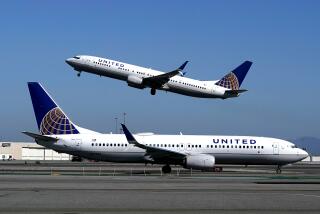United Airlines Is Rejected Again for Loan Guarantee
- Share via
Uncle Sam won’t be handing a parachute to troubled United Airlines.
The U.S. government Monday swiftly rejected the final plea by United and its parent, UAL Corp., for a $1.1-billion loan guarantee to help it emerge from bankruptcy.
United’s employees made sizable wage and benefit concessions in the last two years, and now further job reductions could be in the offing, analysts said. “Employees are probably going to be hit up again,” said Ron Kuhlmann, an analyst at Unisys R2A Transportation Management Consultants in Oakland.
Darren Shiroma of Torrance, a United flight attendant for nine years, said he was in shock Monday in light of “all the hard work and dedication that employees put into bringing United back” -- by accepting contracts that, among other things, trimmed flight attendant wages 9%, saving United about $314 million a year.
Additional give-backs could be especially acute in California, where United has more employees -- 16,300 -- than in any other state. The carrier has 814 daily flights and 26 destinations in California and is the busiest airline at the Los Angeles and San Francisco international airports.
UAL, based in suburban Chicago, said it was disappointed by the decision and would “take the actions necessary to further reduce costs and improve revenue.” But it didn’t provide details and its executives declined to elaborate.
Still, the airline said it was undeterred by the government’s action and was holding talks with lenders to secure the financing it needed to emerge from bankruptcy protection.
Some analysts also have speculated that UAL might reduce its schedule, sell some routes or divest itself of other assets to bolster its financial health. But the company said the ruling would not immediately affect United’s service or flight schedule.
UAL’s stock, which is traded over the counter, dropped 7 cents to $1.33.
The airline’s request for loan backing was rebuffed twice before -- most recently June 17 -- by the Air Transportation Stabilization Board, which was formed to help the industry after the Sept. 11, 2001, terrorist attacks caused air travel to plummet and saddled the airlines with massive losses.
The federal panel does not lend money but provides loan guarantees to help airlines get more favorable credit terms from the financial markets. U.S. taxpayers would be on the hook, however, if the airline defaulted on the U.S.-backed loans.
UAL, the nation’s second-largest carrier after AMR Corp.’s American Airlines, has lost more than $8 billion since 2000. UAL first sought a loan guarantee of $1.8 billion. After it was rejected in December 2002, the airline quickly filed for Chapter 11 bankruptcy reorganization.
The second failed request was for $1.6 billion in backing. Last week the carrier pared its proposal again, to $1.1 billion, and offered to raise about $500 million on its own to bolster its application.
But the three-member ATSB waited less than a week to unanimously reject it again. The panel reiterated its belief that federal aid for UAL “is not a necessary part of maintaining a safe, efficient and viable commercial aviation system” as required by the ATSB’s mandate.
The board also said it would not accept any future requests from UAL, which had revenue last year of $13.7 billion.
United’s labor unions and some Illinois politicians have criticized the ATSB, contending the panel is exacerbating the airline’s tenuous position, threatening jobs and lowering wages.
“The campaign by a gaggle of analysts and politicians to deny United any financial aid is clearly aimed at reducing labor costs industrywide,” Robert Roach Jr., vice president of the International Assn. of Machinists and Aerospace Workers, which represents 27,000 United ground workers, said in a statement Monday.
But some rival airlines and free-market advocates have said UAL shouldn’t get help because many of its financial and labor problems were self-inflicted and occurred before the terrorist attacks.
Continental Airlines said on Monday that although United “is a great franchise with exceptional employees,” it applauded the ATSB and said the marketplace should “determine the shape of the industry.”
In rebuffing UAL, the panel did note that UAL had taken “positive steps” to reduce its costs and “strengthen its competitive position.” The board also asserted that opportunities for raising cash in the credit markets had improved in the last two years, “increasing the likelihood of United succeeding without a loan guarantee.”
UAL and its chief executive, Glenn Tilton, frequently get high marks from analysts for making considerable strides in streamlining United’s operations since Tilton arrived at the airline in September 2002. The carrier has slashed about $5 billion in annual costs, including more than $2 billion that came from employee concessions.
Even so, United’s employees generally have pulled together, and the airline’s customer service and on-time performance have improved. UAL also has narrowed its losses in recent quarters, and its widespread route system remains a formidable asset.
Yet United still has one of the highest cost structures in the business. That’s complicating its effort to regain profitability -- especially with fuel prices soaring so high -- and leaving it vulnerable to the burgeoning strength of low-cost, low-fare carriers such as Southwest Airlines and JetBlue Airways.
Kuhlmann of Unisys R2A contends that with or without government aid, United still has not laid out a viable plan to ensure its long-term survival.
“There needs to be a clear statement of what they’re going to look like in five years,” he said.
More to Read
Inside the business of entertainment
The Wide Shot brings you news, analysis and insights on everything from streaming wars to production — and what it all means for the future.
You may occasionally receive promotional content from the Los Angeles Times.











